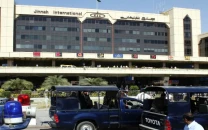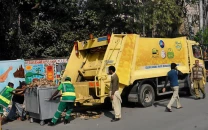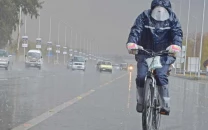The Tharparkar ‘mela’
Disbursing cash and wheat as a short-term plan is useless — what will the Tharis do once the aid runs out

The writer is a teacher at the Orange Tree Foundation and product development manager at Astor International
Mithi is not a drought-affected area. It is only a “convenient” area to drop off goods, be seen and rid oneself of the burden of having done something. Of the millions being spent in relief, I don’t see any of it going through the right framework of distribution, neither do I see any of it going to the real affectees.
Which brings us to the next point — who are these affectees and where do they come from? Ninety-two per cent of the population of Tharparkar lives in the rural areas, hours away from Mithi city. These areas have been suffering from countless problems since many years now. It is important to understand that in today’s day and age, drought does not kill anyone — the mismanagement of the after-effects does. Tharparkar sees rain and it sure does have water in most areas, with several NGOs and the government having installed tube wells and handpumps everywhere. The migration occurring is also quite normal as many Tharis lead a nomadic lifestyle due to their means of livelihood. What is the problem then? Let’s begin with the basics.
Toxic water is a key issue. Tharparkar is dependent on underground water. Villages in Thar have both fresh and brackish water. However, a significant quantity is known to be contaminated. Various surveys and news stories have confirmed that water contamination of late is causing miscarriages, gynaecological problems, gastric problems and more. This is a huge task to conquer because the cost and implementation of desalination, defluoridation and reverse osmosis plants for over 2,400 villages will be tedious and expensive.
Then, there is the problem of livestock virus. A villager’s asset is his livestock. Despite the government’s vaccination efforts in 2012, there has been a roaring outbreak of viruses and not enough has been done to curtail the after-affects. With sheep pox being common, families have been forced to sell their livestock at throwaway prices due to fear of complete loss. In addition, they lose out on the nutrients received through milk, adding to their overall malnourishment.
Moreover, rural culture in almost all of Sindh dictates that the woman wakes up at the crack of dawn, works the field, collects water, finds wood for fire, looks after her numerous kids and performs other duties. Most Thari women are malnourished to begin with and so busy with their routine tasks that they do not often breastfeed their already underweight infants, who need extra care. This results in the infants succumbing to disease and ailments. Poor hygiene also contributes as a huge factor.
The taluka hospitals are still far from remote villages which reduce the chances of the patients actually getting treatment.
On the other hand, 2012 saw many villagers raise their voices against the food department for hoarding their wheat — this coupled with lack of crop turnover and loss of livestock has placed families in more poverty than ever before. All this clamour fell on deaf ears. Wheat is now being released when and where convenient — but this is a short-term solution. Distribution systems need to be in check and balance constantly, with attention being paid to developing the agriculture sector.
Tharparkar had been declared a calamity-hit area in September 2013 (and 1968, 1978, 1985, 1986, 1987, 1995, 1996, 1999, 2001, 2004, 2005, 2007). The short-term solidarity and support Tharis are gaining will do them no good if not followed up by a long-term plan that includes accountability. Disbursing cash and wheat as a short-term plan is useless — what will the Tharis do once the aid runs out and the medical volunteers stop visiting them?
Published in The Express Tribune, March 29th, 2014.
Like Opinion & Editorial on Facebook, follow @ETOpEd on Twitter to receive all updates on all our daily pieces.















COMMENTS
Comments are moderated and generally will be posted if they are on-topic and not abusive.
For more information, please see our Comments FAQ